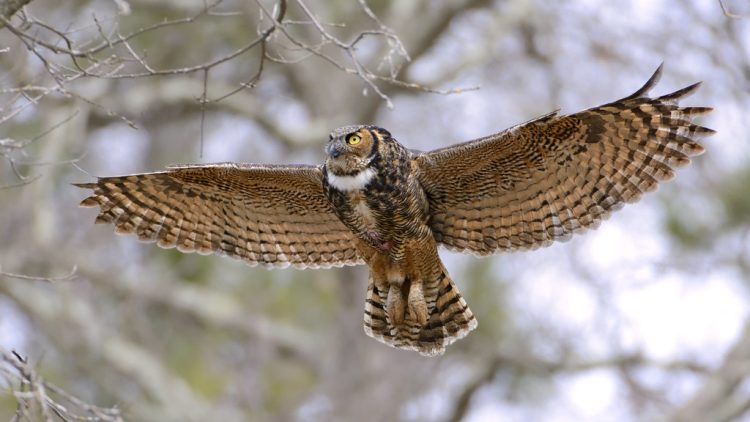The Majestic Great Horned Owl in Illinois: Silent Wings of the Night

Illinois, the heart of the American Midwest, is home to a diverse range of wildlife, and among its many fascinating creatures, the Great Horned Owl (Bubo virginianus) stands out as one of the most iconic and awe-inspiring. With its piercing yellow eyes, distinctive ear tufts, and haunting nocturnal calls, the Great Horned Owl is a symbol of the wild and mysterious beauty that thrives in the state. In this article, we delve into the world of the Great Horned Owl in Illinois, exploring its characteristics, habitat, behavior, and the crucial role it plays in maintaining the delicate balance of the ecosystem.
Physical Characteristics:
The Great Horned Owl, often referred to as the “tiger of the sky,” is a large and powerful bird of prey that commands attention with its striking appearance. Measuring between 18 to 25 inches in length and boasting a wingspan of 3.3 to 4.8 feet, these majestic owls are well-equipped for life as nocturnal hunters. One of their most distinguishing features is the pair of prominent ear tufts atop their heads, resembling horns, which contribute to their imposing and regal appearance.
Their plumage varies in color, ranging from mottled brown to gray, providing excellent camouflage against the bark of trees. The facial disc, a characteristic feature of most owl species, aids in directing sound towards their keen ears, allowing them to locate prey with exceptional precision even in low light conditions. The intense yellow eyes of the Great Horned Owl are adapted for night vision, further enhancing their hunting capabilities.
Habitat and Range:
Great Horned Owls are highly adaptable and can be found in a variety of habitats, from dense forests and wooded areas to open fields and urban environments. In Illinois, they have established a strong presence across the state, including both rural and suburban areas. They are particularly drawn to regions with a mix of open spaces for hunting and tall trees for nesting and roosting.
The deciduous and coniferous forests of Illinois provide ideal conditions for these owls, offering a diverse range of prey species and ample nesting sites. Great Horned Owls are known to inhabit both lowland and upland areas, showcasing their ability to thrive in different landscapes.
Behavior and Hunting:
As nocturnal predators, Great Horned Owls are supremely adapted to hunting in the dark. Their diet is diverse, consisting of mammals such as rabbits, squirrels, and rodents, as well as birds, reptiles, and even other owls. Their powerful talons and strong beaks make them formidable hunters capable of taking down prey larger than themselves.
The hunting strategy of the Great Horned Owl relies on stealth and surprise. With silent flight aided by specialized feathers, these owls can approach their prey without creating the typical sound associated with flapping wings. Their acute hearing enables them to locate prey by sound alone, further enhancing their efficiency as hunters.
Reproduction and Nesting:
Great Horned Owls typically mate for life, and their breeding season begins in late winter. Nesting sites vary and can include abandoned nests of other large birds, tree cavities, or even human-made structures such as buildings and platforms. The female owl lays one to five eggs, and both parents share the responsibilities of incubating the eggs and caring for the young.
The owlets hatch after about a month and are covered in a downy plumage. As they grow, the parents diligently provide food for their offspring, teaching them essential hunting skills. The family bond is strong, and young Great Horned Owls often remain with their parents for several months before venturing out on their own.
Conservation and Threats:
While the Great Horned Owl is not currently considered a species of conservation concern, it faces various threats in the changing landscape of Illinois. Habitat loss due to urbanization and deforestation can limit their nesting and hunting grounds. Additionally, collisions with vehicles, poisoning from ingesting rodenticides, and illegal hunting pose risks to their populations.
Conservation efforts in Illinois aim to address these challenges by promoting habitat preservation, raising awareness about the importance of these apex predators in controlling rodent populations, and implementing measures to reduce human-wildlife conflicts.
Conclusion:
The Great Horned Owl, with its majestic presence and silent nocturnal flights, adds a touch of enchantment to the diverse ecosystems of Illinois. As a symbol of the untamed beauty of the wild, these owls play a crucial role in maintaining the balance of the state’s ecosystems by controlling rodent populations and contributing to the intricate web of life. As stewards of the environment, it is our responsibility to appreciate and protect these magnificent creatures, ensuring that future generations can continue to marvel at the silent wings of the night in the Illinois skies.




